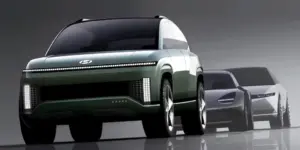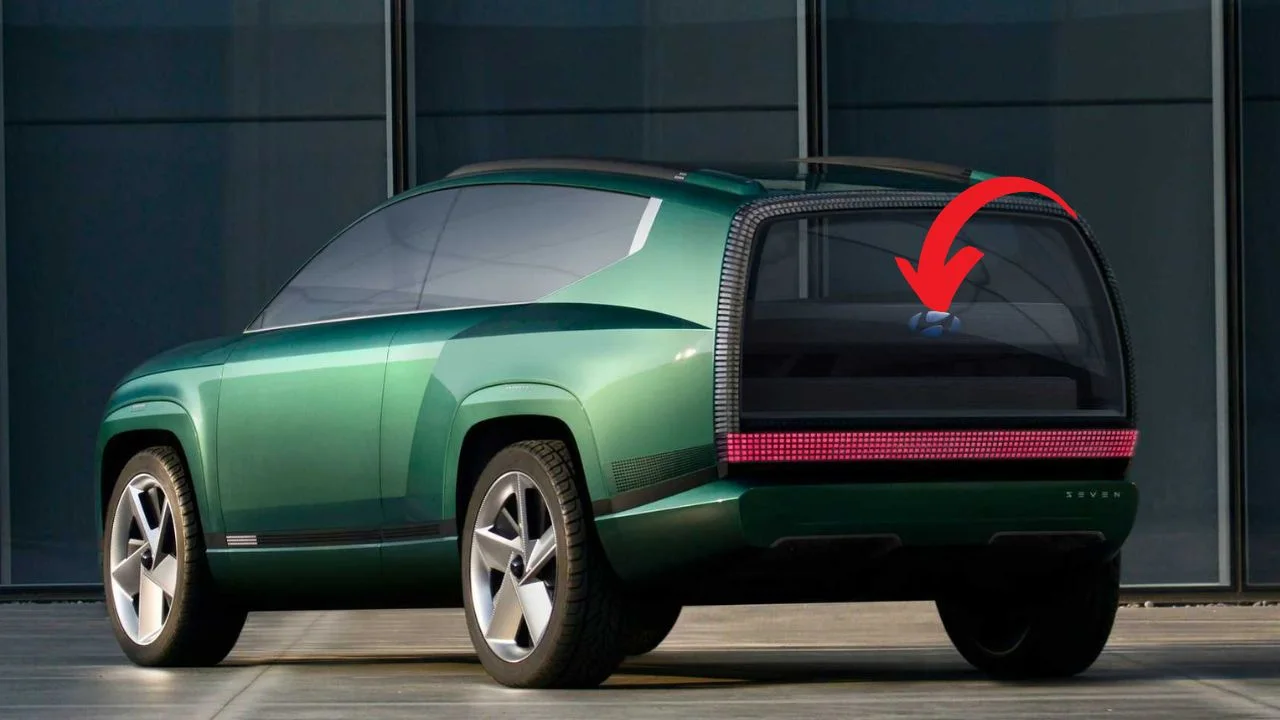The electric vehicle (EV) market in Australia is rapidly evolving, with consumers increasingly seeking sustainable, spacious, and technologically advanced options for family transport. Hyundai, a brand synonymous with innovation in the EV space, has unveiled its latest offering: the 2025 Hyundai Ioniq 9. This three-row, all-electric SUV, set to arrive in Australian showrooms by June 2025, promises to redefine the large SUV segment with its impressive 620km range, cutting-edge technology, and family-focused design. But does the Ioniq 9 truly represent the future of electric SUVs in Australia? This article explores the vehicle’s features, its market positioning, challenges, and whether it can lead the charge toward widespread EV adoption.
Introducing the Hyundai Ioniq 9
The Hyundai Ioniq 9 is the largest and most ambitious electric vehicle in Hyundai’s lineup, joining the Ioniq 5 crossover and Ioniq 6 sedan. Unveiled at the Los Angeles Auto Show in November 2024, the Ioniq 9 is a seven-seat (or six-seat) SUV built on Hyundai’s Electric-Global Modular Platform (E-GMP), shared with its sibling, the Kia EV9. Measuring over five meters long (5060mm) with a 3130mm wheelbase, it dwarfs competitors like the Toyota LandCruiser 300 Series in most dimensions, except height. Its “Aerosthetic” design blends aerodynamic efficiency with futuristic styling, featuring Parametric Pixel LED headlights, a sleek roofline, and flush surfaces for a low drag coefficient.
The Ioniq 9 is powered by a 110.3kWh nickel-manganese-cobalt (NMC) lithium-ion battery, delivering a WLTP-estimated range of 620km in its Long-Range rear-wheel-drive (RWD) configuration with 19-inch wheels. It supports ultra-fast charging, achieving a 10-80% charge in just 24 minutes on a 350kW DC charger, thanks to its 800-volt architecture. The SUV offers multiple powertrains: a base RWD model with 160kW/350Nm, a Long-Range all-wheel-drive (AWD) variant with 230kW/605Nm, and a Performance AWD model with 320kW/700Nm, capable of 0-100km/h in 5.2 seconds. With a 2500kg braked towing capacity and vehicle-to-load (V2L) functionality, the Ioniq 9 is versatile for family adventures and practical needs.
Key Features: A Family-First Electric SUV
The Ioniq 9’s interior is designed as a “lounge-like” space, prioritizing comfort and flexibility. It offers six- or seven-seat configurations (2+2+2 or 2+3+2), with second-row captain’s chairs or swiveling seats available in some markets. The flat floor, enabled by the E-GMP platform, maximizes legroom (up to 2050mm combined for second and third rows) and headroom (1899mm). A slidable Universal Island 2.0 console moves up to 190mm, enhancing storage and accessibility. Relaxation Seats in the first and second rows fully recline with leg rests, and some include massage functions to stimulate blood flow during charging stops.
Technology is a standout, with dual 12-inch displays (a digital cluster and infotainment touchscreen) integrated into a curved panel. Features include a 14-speaker Bose sound system, digital side mirrors, a panoramic glass roof, and 100W USB-C ports across all rows. Hyundai’s AI-powered voice assistant and Feature on Demand system allow over-the-air updates for lighting patterns, streaming services, and display themes. Safety is robust, with 10 airbags, a reinforced body for battery protection, and advanced driver assistance systems (ADAS) like autonomous emergency braking, lane-keep assist, and blind-spot monitoring.
Hyundai emphasizes sustainability, using recycled plastic yarn for roof linings, eco-leather, wool, and recycled suede upholstery, and repurposed tire waste in exterior paint. These elements align with Australia’s growing demand for eco-conscious vehicles.
The Australian Context: Why the Ioniq 9 Matters
Australia’s EV market is expanding, with 8.7% of new car sales in 2024 being electric, up from 3.8% in 2022. However, large SUVs remain a dominant segment, with models like the Toyota LandCruiser and Ford Everest leading sales. The Ioniq 9 enters a niche but growing sub-segment of large electric SUVs, where options are limited to the Kia EV9, Volvo EX90, and luxury models like the Tesla Model X. Its arrival in Q2 2025 (April-June) positions it to capitalize on increasing consumer interest in EVs, particularly for families needing space and range.
The Ioniq 9’s 620km range addresses a key concern for Australian buyers: range anxiety, especially for long-distance travel in a country with vast distances and limited charging infrastructure. Its 2500kg towing capacity appeals to those needing to haul trailers or caravans, a common requirement in Australia. The V2L feature, allowing the vehicle to power external devices, is ideal for camping or worksites, aligning with the Australian lifestyle.
Competitive Landscape: How Does It Stack Up?
The Ioniq 9’s primary rival is the Kia EV9, which shares its E-GMP platform but offers a smaller 99.8kWh battery and up to 512km range. Priced between $97,000 and $121,000 before on-road costs, the EV9 has sold modestly (490 units in 2024), suggesting a limited but dedicated market for large electric SUVs. The Ioniq 9, with its larger battery and longer range, is expected to start above $100,000, with top-spec Calligraphy models potentially exceeding $140,000. This places it in premium territory, competing with the Volvo EX90 ($130,000-$150,000 est.) and Tesla Model X ($150,000+).
Compared to the EV9, the Ioniq 9 offers a more refined interior, greater range, and unique features like swiveling seats and AI-driven terrain modes. However, its higher price may deter cost-conscious buyers. Against the EX90, the Ioniq 9 lacks air suspension but counters with faster charging and a lower entry price. The Model X, with its falcon-wing doors and 560km range, appeals to luxury buyers but lacks the Ioniq 9’s family-focused practicality.
Traditional internal combustion engine (ICE) SUVs like the Mazda CX-90 and Toyota LandCruiser remain popular, offering diesel or hybrid options and established reliability. The Ioniq 9 must convince these buyers to switch to electric, a challenge given Australia’s slower EV adoption compared to Europe or China.
Challenges for the Ioniq 9 in Australia
Despite its strengths, the Ioniq 9 faces hurdles in reshaping Australia’s SUV market:
-
Price Sensitivity: Starting above $100,000, the Ioniq 9 is a premium purchase. While government subsidies (e.g., Queensland’s $6,000 EV rebate) and lower running costs (20% cheaper than petrol, per Hyundai) help, the upfront cost may deter buyers accustomed to sub-$80,000 ICE SUVs.
-
Charging Infrastructure: Australia’s public charging network is growing (over 3,000 stations in 2025), but regional coverage remains patchy. The Ioniq 9’s fast-charging capability relies on 350kW chargers, which are scarce outside major cities. Home charging (7.4kW or 22kW Wallbox Pulsar Plus) requires additional installation costs.
-
Market Appetite: Large electric SUVs are a niche segment. The Kia EV9’s 490 sales in 2024 contrast with Toyota’s 13,464 LandCruisers, highlighting a preference for ICE vehicles. Convincing families to embrace EVs requires overcoming perceptions of limited range and charging inconvenience.
-
Weight and Dynamics: At over 2,600kg (similar to the EV9), the Ioniq 9’s weight impacts handling, despite self-leveling dampers and dynamic torque vectoring. Australian roads, with their coarse surfaces and winding routes, will test its refinement.
-
Competition: Emerging Chinese brands like BYD and GWM offer affordable EVs, while Hyundai’s own Inster (a sub-$40,000 electric SUV) may cannibalize budget-conscious buyers. Premium brands like Mercedes-Benz (EQS SUV) and BMW (iX) also vie for high-end customers.

Is the Ioniq 9 the Future?
The Hyundai Ioniq 9 embodies the future of electric SUVs in several ways. Its 620km range and 24-minute charging time push the boundaries of EV practicality, addressing Australian-specific needs like long-distance travel and towing. Its spacious, tech-laden interior caters to families, while sustainable materials align with environmental priorities. Hyundai’s commitment to 23 EV models by 2030, with the Ioniq 9 as a flagship, signals a bold electrification strategy.
However, the Ioniq 9’s success hinges on overcoming Australia’s unique challenges. Its premium price and reliance on charging infrastructure may limit mass appeal, especially in a market where ICE SUVs dominate. The vehicle’s size and weight could also alienate buyers seeking agile, urban-friendly SUVs. While it outperforms the Kia EV9 in range and refinement, its higher cost and niche positioning may cap sales volume.
The Ioniq 9 is not a singular “game-changer” but a significant step toward normalizing large electric SUVs. It appeals to early adopters, eco-conscious families, and tech enthusiasts willing to invest in a premium EV. For widespread adoption, Australia needs more affordable EVs, expanded charging networks, and cultural shifts away from ICE vehicles. Hyundai’s broader lineup, including the Kona Electric and Inster, complements the Ioniq 9 by catering to diverse budgets and needs.
What’s Next for the Ioniq 9 in Australia?
The Ioniq 9 is slated for a late Q2 2025 launch, with test vehicles already spotted in Australia. Hyundai has approved multiple variants for local sale, including Long-Range RWD, Long-Range AWD, and Performance AWD, with six- or seven-seat options. Pricing remains unconfirmed, but expect a base Exclusive grade near $100,000 and a Calligraphy variant around $140,000. Features like self-leveling suspension, digital reversing mirrors, and heated/cooled seats are likely standard on higher trims.
Interested buyers can register on Hyundai Australia’s website for updates, with local dealers contacting them upon launch. Test drives in mid-2025 will be crucial for gauging real-world performance on Australian roads. Hyundai’s Bluelink app will allow remote monitoring of charging and vehicle status, enhancing ownership convenience.
In Summary
The Hyundai Ioniq 9 is a compelling vision of the electric SUV future, blending range, space, and technology to meet family needs. Its 620km range, fast charging, and versatile features make it a strong contender in Australia’s growing EV market. However, its premium price, infrastructure challenges, and competition from ICE and rival EVs temper its transformative potential. For affluent families and EV enthusiasts, the Ioniq 9 offers a glimpse into a sustainable, high-tech future. For the broader market, it’s a bold step—but not the sole answer. As Australia’s EV landscape matures, the Ioniq 9 will play a pivotal role in shaping perceptions and driving adoption, paving the way for a cleaner, electrified tomorrow.
